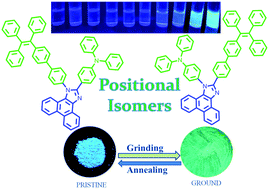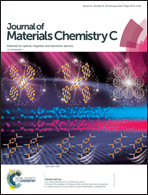Stimuli responsive AIE active positional isomers of phenanthroimidazole as non-doped emitters in OLEDs†
Abstract
The development of mechanochromic materials by incorporating aggregation induced emission (AIE) luminogens has gained momentum owing to their wide range of applications in optoelectronics. In this work, the authors contribute to the development of AIE active mechanochromic phenanthroimidazole derivatives. The positional isomers of phenanthroimidazoles 1 and 2 were designed to study the effect of the position of triphenylamine (TPA) and tetraphenylethylene (TPE) units on their AIE and mechanochromism. Phenanthroimidazoles 1 and 2 were synthesized using the Suzuki cross-coupling reaction of TPE boronate ester with iodo-phenanthroimidazole of TPA and bromo-phenanthroimidazole of TPA, respectively. The single crystal X-ray analysis of 1 reveals a propeller orientation of multiple phenyl rings of the TPA and TPE units, confirming strong AIE characteristics of 1 and 2. Phenanthroimidazoles 1 and 2 exhibit reversible mechanochromism between blue and green colours, which was studied using powder X-ray diffraction (PXRD). The PXRD studies suggest that a phase transition from a crystalline state to an amorphous state is associated with the colour change. Moreover, phenanthroimidazoles 1 and 2 worked efficiently as non-doped emitters based on the AIE character and provided a high external quantum efficiency of 2.8 and 4.0%, respectively.

- This article is part of the themed collections: 10th Anniversary: Dedicated Authors and Aggregation-Induced Emission with Bin Liu and Ben Zhong Tang


 Please wait while we load your content...
Please wait while we load your content...